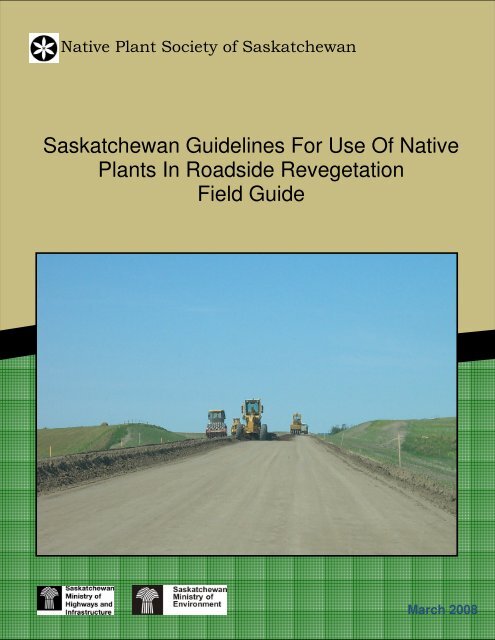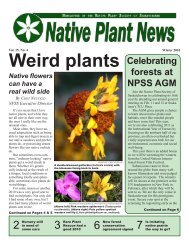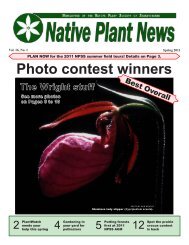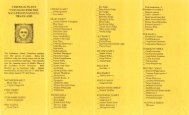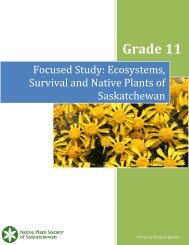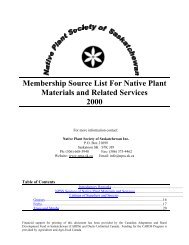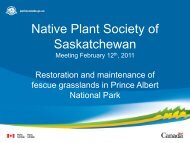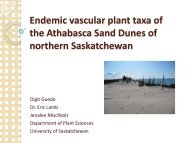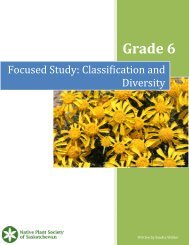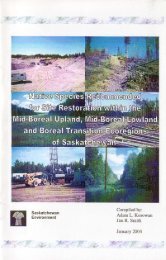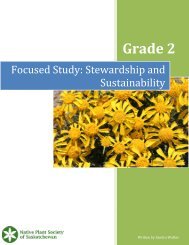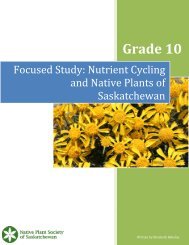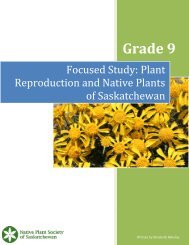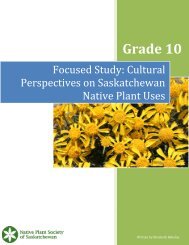Saskatchewan Guidelines For Use Of Native Plants In Roadside ...
Saskatchewan Guidelines For Use Of Native Plants In Roadside ...
Saskatchewan Guidelines For Use Of Native Plants In Roadside ...
You also want an ePaper? Increase the reach of your titles
YUMPU automatically turns print PDFs into web optimized ePapers that Google loves.
<strong>Saskatchewan</strong> <strong>Guidelines</strong> <strong>For</strong> <strong>Use</strong> <strong>Of</strong> <strong>Native</strong> <strong>Plants</strong> <strong>In</strong> <strong>Roadside</strong> Revegetation<br />
Field Guide<br />
<strong>Native</strong> Plant Society of <strong>Saskatchewan</strong><br />
<strong>Saskatchewan</strong> <strong>Guidelines</strong> <strong>For</strong> <strong>Use</strong> <strong>Of</strong> <strong>Native</strong><br />
<strong>Plants</strong> <strong>In</strong> <strong>Roadside</strong> Revegetation<br />
Field Guide<br />
March 2008
<strong>Saskatchewan</strong> <strong>Guidelines</strong> <strong>For</strong> <strong>Use</strong> <strong>Of</strong> <strong>Native</strong> <strong>Plants</strong> <strong>In</strong> <strong>Roadside</strong> Revegetation<br />
Field Guide<br />
Recommended citation:<br />
Neufeld, C.R. 2008. <strong>Saskatchewan</strong> <strong>Guidelines</strong> <strong>For</strong> <strong>Use</strong> <strong>Of</strong> <strong>Native</strong> <strong>Plants</strong> <strong>In</strong> <strong>Roadside</strong><br />
Revegetation – Field Guide. <strong>Native</strong> Plant Society of <strong>Saskatchewan</strong> and <strong>Saskatchewan</strong><br />
Ministry of Transportation and <strong>In</strong>frastructure, Saskatoon, SK. ii + 25 pp.<br />
This manual was produced through the generous support of the <strong>Saskatchewan</strong> Ministry of<br />
Highways and <strong>In</strong>frastructure and the <strong>Saskatchewan</strong> Ministry of Environment.<br />
Cover photo: © <strong>Native</strong> Plant Society of <strong>Saskatchewan</strong>
<strong>Saskatchewan</strong> <strong>Guidelines</strong> <strong>For</strong> <strong>Use</strong> <strong>Of</strong> <strong>Native</strong> <strong>Plants</strong> <strong>In</strong> <strong>Roadside</strong> Revegetation<br />
Field Guide<br />
Table of Contents<br />
<strong>In</strong>troduction ......................................................................................................................... 4<br />
I. Preparation ....................................................................................................................... 4<br />
1. Preliminary Plan.......................................................................................................... 4<br />
A. Timeline ..................................................................................................................... 4<br />
B. People <strong>In</strong>volved .......................................................................................................... 4<br />
C. Budget ........................................................................................................................ 4<br />
2. Photos .......................................................................................................................... 5<br />
3. Vegetation Survey ....................................................................................................... 5<br />
4. Weed Control .............................................................................................................. 5<br />
5. Topsoil Retention ........................................................................................................ 6<br />
A. Erosion ...................................................................................................................... 7<br />
6. Seed/Plant Sources ...................................................................................................... 8<br />
A. Natural Regeneration ................................................................................................. 8<br />
B. Wild-harvesting .......................................................................................................... 8<br />
C. Sod Stripping .............................................................................................................. 9<br />
D. <strong>Native</strong> Hay Mulch ...................................................................................................... 9<br />
E. Purchasing <strong>Native</strong> Seed ............................................................................................ 10<br />
7. Determining Which Seed Mix to <strong>Use</strong> ....................................................................... 10<br />
8. Seeding Methods ....................................................................................................... 11<br />
A. Broadcast Seeding .................................................................................................... 11<br />
B. Drill Seeding ............................................................................................................ 12<br />
C. Spreading <strong>Native</strong> Hay Mulch ................................................................................... 12<br />
D. Hydro-seeding .......................................................................................................... 12<br />
II. Post-Construction Site Preparation .............................................................................. 13<br />
1. Weed Control ............................................................................................................ 13<br />
2. Soil Preparation ......................................................................................................... 13<br />
3. Other Considerations ................................................................................................ 14<br />
III. Revegetation ............................................................................................................... 14<br />
1. Laying Sod ................................................................................................................ 14<br />
2. Seeding ...................................................................................................................... 14<br />
A. Broadcast Seeding .................................................................................................... 15<br />
B. Drill Seeding ............................................................................................................ 16<br />
C. Spreading <strong>Native</strong> Hay Mulch ................................................................................... 17<br />
D. Hydro-seeding .......................................................................................................... 18<br />
IV. Post Planting Management ......................................................................................... 19<br />
1. Weed Control ............................................................................................................ 19<br />
2. Watering .................................................................................................................... 19<br />
3. Seedling Establishment Survey................................................................................. 19<br />
4. Other Important Considerations ................................................................................ 20
<strong>Saskatchewan</strong> <strong>Guidelines</strong> <strong>For</strong> <strong>Use</strong> <strong>Of</strong> <strong>Native</strong> <strong>Plants</strong> <strong>In</strong> <strong>Roadside</strong> Revegetation<br />
Field Guide<br />
Please read the manual entitled “<strong>Saskatchewan</strong> <strong>Guidelines</strong> for <strong>Use</strong> of <strong>Native</strong> <strong>Plants</strong> in<br />
<strong>Roadside</strong> Revegetation – Reference Manual” before using this field guide.<br />
<strong>In</strong>troduction<br />
<strong>Native</strong> revegetation is a large undertaking, even for small areas. Essentially, the field of<br />
native revegetation is still developing in Canada, as many aspects of Canadian native<br />
plant ecology are still not well understood. However, the number of informational<br />
sources and experts are growing, as are the revegetation successes. The process of<br />
revegetation is a delicate blend of science and art; the project manager must use the best<br />
science at the time and match it with proven techniques. Because of this, the best asset in<br />
any native plant revegetation is a project leader with experience. Even the best manual<br />
will only spell out the steps and caution against possible pitfalls, but only experience<br />
brings true foresight with it. Luckily, the more revegetations one does the more<br />
experience they gain and the easier the process becomes.<br />
I. Preparation<br />
Long before any revegetation is to be done, educate or re-educate yourself with literature<br />
relevant to the revegetation, as new information is always being developed. Read this<br />
field guide and its accompanying reference manual. Also consult any local experts, and<br />
have them contribute to or comment on the work plan. The following steps outline the<br />
ideal preparation process:<br />
1. Preliminary Plan<br />
A. Timeline<br />
Outline everything that needs to get done in a step-by-step manner, and include<br />
start and end dates for each step. This will make it easier to visualize the entire<br />
revegetation process and how every component fits into the larger picture. It will<br />
also allow the people involved to see when a particular portion of the process is<br />
taking longer than expected so that corrective measures can be taken before the<br />
whole revegetation process falls behind.<br />
B. People <strong>In</strong>volved<br />
Make a list of everyone involved in the revegetation process and include their<br />
roles and/or specific duties. This is important during the process to ensure that<br />
everyone is doing what they should so that everything runs smoothly, and to use<br />
as a reference after the revegetation is complete. Organizing the list as a<br />
hierarchical chart may also help identify the chain of command.<br />
C. Budget<br />
Prepare a projected budget for the project so that costs can be monitored.<br />
Ultimately, it is up to the project managers to determine the budget structure;<br />
however, all material, equipment, and personnel costs should be identified.
<strong>Saskatchewan</strong> <strong>Guidelines</strong> <strong>For</strong> <strong>Use</strong> <strong>Of</strong> <strong>Native</strong> <strong>Plants</strong> <strong>In</strong> <strong>Roadside</strong> Revegetation<br />
Field Guide<br />
It may be beneficial to link the timeline, list of people involved and the budget, so that<br />
every step of the process has a related list of people and costs involved.<br />
2. Photos<br />
Take photos of the site and keep a record of the date. If possible, include a landmark in<br />
the photo such as a road sign. This will allow you to return to the same location to take<br />
comparative photos, so that changes can be tracked. Sites with a timeline of comparative<br />
photo records are often referred to as a photo plots.<br />
3. Vegetation Survey<br />
Next, have an experienced botanist do a survey of the roadside vegetation that will be<br />
affected by the construction. The surveyor should not only include the species names,<br />
but also the percentage of the community that they comprise. This will allow a<br />
comparison of the existing community to that proposed in the seeding guidelines and<br />
allow for possible modifications to the guidelines. Plant communities in adjacent areas<br />
should be recorded, as they may influence the revegetation site in the future. The<br />
surveyor should also make special note of any weeds on or near the site, particularly<br />
perennial weeds, as these will most likely pose problems in the future. <strong>In</strong> addition to<br />
weeds, the surveyor should make note of any ‘unusual’ areas on the site such as saline<br />
burnouts, sandy areas or depressions with water in them. The conditions that formed<br />
these areas will likely persist even after construction is finished and the species mix<br />
recommended for revegetation will probably not work in them as they were developed<br />
for ‘normal’ conditions in the area. Small amounts of seed adapted to these ‘unusual’<br />
areas such as the recommended mixes for saline or sandy areas will have to be used. <strong>In</strong><br />
the case of water-filled depressions, it may be acceptable to use the normal species mix<br />
suggested for the area, as most of the species are able to grow in moister conditions. The<br />
result will merely be higher, denser vegetation. It may be helpful if the surveyor sketches<br />
a map of the area, noting any features, or if they overlay features on an air photo. This<br />
will give a better visual conception of the site for anyone wishing to gain a better<br />
understanding of the situation.<br />
Figure 1. A botanist marking a transect<br />
line in preparation for a vegetation survey.<br />
Photo by Dean Nernberg, Canadian<br />
Wildlife Service/Environment Canada.<br />
4. Weed Control<br />
If perennial or other problematic weeds are found, it is<br />
advantageous to treat them even before construction<br />
begins. This is particularly important, as the site will<br />
not likely receive the recommended several years of<br />
weed treatment prior to revegetation due to the<br />
accelerated schedule of road construction. Although<br />
construction will remove the top growth if the soil is<br />
scraped away, the plants’ roots and rhizomes<br />
(horizontal creeping roots) may be left, enabling the
<strong>Saskatchewan</strong> <strong>Guidelines</strong> <strong>For</strong> <strong>Use</strong> <strong>Of</strong> <strong>Native</strong> <strong>Plants</strong> <strong>In</strong> <strong>Roadside</strong> Revegetation<br />
Field Guide<br />
plants to regenerate. Also, the plants may have set seed in the local area, which will<br />
germinate once construction has ended. Aggressively treating these species before and<br />
after construction is a must for successful revegetation. If these types of problematic<br />
weeds exist off-site, such as on adjacent private land, the chance of infestation of the<br />
roadside from these sites is almost certain and there is little one can do, other than<br />
contacting the landowner or a Provincial weed inspector and having them treat the<br />
problem. Landowners are required to treat weeds listed in the <strong>Saskatchewan</strong> Noxious<br />
Weed Act of 1984, and Provincial weed inspectors are authorized to inspect private land<br />
for these species and order their removal. It should be noted that herbicide be applied<br />
only by licensed herbicide applicators and at the approved rates. Herbicides should not<br />
be used around water bodies; mechanical or manual methods should be pursued in this<br />
case. <strong>In</strong>troduced grass species such as crested wheatgrass (Agropyron cristatum) and<br />
smooth brome (Bromus inermis) are very aggressive and compete with native species to<br />
the point of invading even healthy stands of native grass. <strong>For</strong> these reasons, invasions by<br />
these grasses should be treated immediately and aggressively.<br />
Relatively harmless annual weeds such as flixweed (Descurainia sophia) do not need to<br />
be sprayed as they do not impact the establishment of native seedlings, and some research<br />
has found that they may even promote the establishment of native species by enhancing<br />
site conditions (93). If control of these annual weeds is desired, mowing them before<br />
seed set will usually suffice. Below is a list of weed control options:<br />
A. Herbicide application using the correct herbicide, application rates and<br />
techniques for the problem (consult a current “Guide to Crop Protection”,<br />
distributed by the <strong>Saskatchewan</strong> Ministry of Agriculture).<br />
B. Mowing prior to seed set.<br />
C. Manual control (i.e. hand-pulling).<br />
D. Soil insolation (covering the area with black plastic).<br />
E. Soil impoverishment (introducing large amounts of organic matter into the soil<br />
which consumes excess nitrogen during decomposition, thereby depriving weeds<br />
and giving native seedlings an advantage. This is best done before seeding).<br />
F. Tilling the soil. This only works if the plants are young and are not well<br />
established. Tilling is pointless if the weeds are already flowering.<br />
Combinations of the above may also be especially effective.<br />
5. Topsoil Retention<br />
Care should be taken not to damage any more roadside than necessary. However, if<br />
roadside surfaces will be damaged or destroyed as part of the construction process,<br />
topsoil in the affected areas should be conserved. This could mean laying a barrier down<br />
to prevent erosion during construction, avoiding compaction by heavy equipment or<br />
stripping the topsoil and replacing it after construction has finished. The topsoil is very<br />
important to the vegetation that will occupy the site, as it provides nutrients, organic<br />
matter and beneficial micro-organisms to the plants. It may also contain a native seed<br />
bank that could aid in the revegetation of the site. Caution must be taken to ensure that<br />
replaced topsoil does not contain any noxious weeds. Retaining and reusing topsoil is<br />
very beneficial, but if it contains a seed bank of noxious weeds, they will quickly reestablish<br />
after the topsoil is replaced and dominate the area. <strong>In</strong> this case, the topsoil may<br />
be treated with herbicide during storage if perennial weeds germinate, and should only be
<strong>Saskatchewan</strong> <strong>Guidelines</strong> <strong>For</strong> <strong>Use</strong> <strong>Of</strong> <strong>Native</strong> <strong>Plants</strong> <strong>In</strong> <strong>Roadside</strong> Revegetation<br />
Field Guide<br />
replaced onto the site if it is certain that the topsoil is noxious weed free after treatment.<br />
If the topsoil is not free of the vast majority of noxious weeds, the topsoil should not be<br />
used. If the topsoil contaminated with noxious weed seeds was replaced accidentally or<br />
absolutely must be replaced for some reason, seeding these sites to non-aggressive tame<br />
grasses is recommended. Storing topsoil for prolonged periods should be avoided in<br />
order to keep beneficial fungi and any native seed bank viable. When storing topsoil,<br />
wide and shallow rows should be chosen over deep and narrow piles, as the former is<br />
more beneficial to the survival of any beneficial fungi and/or native seed bank.<br />
A. Erosion<br />
If erosion is a concern, there are many pre-emptive measures that can be used<br />
effectively.<br />
1. Straw crimping – working straw into the soil either before or after<br />
seeding using a straw crimper.<br />
2. <strong>In</strong>cluding rhizomatous species in the seed mix (all of the recommended<br />
seed mixes contain at least one rhizomatous species).<br />
3. Using permeable erosion barriers such as straw matting, coir (coconut<br />
fibre) matting, or a combination of both directly on the soil surface.<br />
4. Spraying the surface with tactifier (a glue-like substance).<br />
5. Revegetating the area with methods better suited to preventing erosion,<br />
such as laying sod, native hay mulching or hydro-seeding.<br />
6. Using various seeding techniques that prevent erosion, like crossseeding<br />
(single passes seeded at right angles to each other) and using a<br />
higher seeding rate.<br />
If watercourses or drainage features are present on the site, other techniques also<br />
exist.<br />
1. Silt fencing – constructing fences out of wooden/metal stakes and<br />
geotextile fabric, placed perpendicular to any slope.<br />
2. Straw rolls – rolling straw or coir matting and pegging it to the surface<br />
perpendicular to the slope.<br />
3. Armouring – placing stones, gravel, concrete rubble or any coarse,<br />
heavy material on surfaces that will be exposed to water scour. Geotextile<br />
fabric also works, although not as well.<br />
Figure 2. Erosion control at<br />
Beaver Creek Conservation<br />
Area after construction on<br />
highway 219. Many different<br />
techniques are being used<br />
here, including armouring a<br />
drainage channel with<br />
interlocking concrete blocks<br />
(bottom left), armouring a scour<br />
area with rock (top center),<br />
installing silt fences along a<br />
watercourse (right center),<br />
placing geotextile fabric on<br />
slopes (right center) and<br />
securing straw matting with<br />
straw rolls on slopes (left
<strong>Saskatchewan</strong> <strong>Guidelines</strong> <strong>For</strong> <strong>Use</strong> <strong>Of</strong> <strong>Native</strong> <strong>Plants</strong> <strong>In</strong> <strong>Roadside</strong> Revegetation<br />
Field Guide<br />
center).<br />
6. Seed/Plant Sources<br />
A. Natural Regeneration<br />
Allowing the natural plant community to revegetate the disturbed area comes with<br />
a number of conditions. First, the area must be small; a large area will not recover<br />
quickly enough and weed infestation and erosion will be problematic. <strong>In</strong> fact, if<br />
problematic weeds are associated with the site, this method should probably be<br />
abandoned. If an area is prone to erosion or will not quickly regenerate, a cover<br />
crop can be planted or straw may be crimped into the surface to stabilize the soil.<br />
Secondly, the site needs a fairly large native seed bank and native plant<br />
community surrounding it to aid the revegetation. The best areas for allowing<br />
natural regeneration are small areas with sufficient moisture surrounded by native<br />
vegetation that is known for rapid growth. No area within any of the ecoregions<br />
is exempt from this method, provided that it possesses the right qualities. Areas<br />
such as forests often make good candidates for natural regeneration because they<br />
have low erosion potential, fewer introduced or invasive species, contain<br />
aggressive native species and have adequate moisture. Wetlands and adjacent<br />
areas are also ideal for natural regeneration because of their high moisture content<br />
and ability to quickly regenerate, and also because commercial seed sources for<br />
wetland species are almost non-existent. The key to using this method is patience<br />
and vigilance. The area may take years to completely revegetate, and must be<br />
monitored so that problems such as erosion and weed infestation can be<br />
immediately dealt with. Although few sites actually qualify for using this<br />
method, the benefit is that when used, it is a low-cost alternative compared to<br />
other methods.<br />
B. Wild-harvesting<br />
Harvesting wild seed from the area needs several considerations. The timing<br />
must be right; if the site is to be revegetated before fall seed collection can be<br />
done, then there is no point in pursuing this any further. Also, the amount of seed<br />
may not be sufficient to re-seed the area and supplemental native seed may be<br />
needed. Several harvest periods may alleviate this if sufficient time exists, or you<br />
may be able to harvest wild seed from local areas, with permission from the<br />
landowners. Several harvest periods during the same growing season may also be<br />
needed to obtain the seed from all the target species. If any noxious weeds are<br />
present, it is generally not wise to collect seed from the area, as noxious weed<br />
seeds may be collected also and seeded with the native species back into the site,<br />
promoting the weed problem. Only collect native seeds in an area with noxious<br />
weeds if the weeds have not yet set seed. Other considerations for the collection<br />
of native seed are the availability of personnel and equipment, and the extra time<br />
and money required for these. Also remember that the wild-harvested seed will<br />
need to be cleaned and tested (seed lab analysis), so allow time and money for this<br />
as well. Certain seed growers will custom harvest and clean native seed.
<strong>Saskatchewan</strong> <strong>Guidelines</strong> <strong>For</strong> <strong>Use</strong> <strong>Of</strong> <strong>Native</strong> <strong>Plants</strong> <strong>In</strong> <strong>Roadside</strong> Revegetation<br />
Field Guide<br />
Figure 3. Wild-harvesting using a<br />
harvester specially-designed for native<br />
seed. Units such as these are versatile<br />
and relatively easy to operate. Photo by<br />
Dean Nernberg, Canadian Wildlife<br />
Service/Environment Canada.<br />
C. Sod Stripping<br />
Stripping native sod is only feasible<br />
for smaller areas, as the cost and<br />
practicality become prohibitive on a<br />
larger scale. Timing is also an<br />
important factor, as the sod can only stay rolled in storage for a relatively short<br />
period of time and does not over-winter. Therefore, it must be collected just prior<br />
to construction and be laid back down as soon as possible after construction. The<br />
benefit of sod over seed is that harvesting sod can occur at any time during the<br />
growing season, while native seed can only be collected in the short window of<br />
time when it is ripe. Another benefit is that the desired plant community is<br />
instantly restored, forming a thick barrier against erosion and weed invasion.<br />
Also, seed cleaning and testing are not required. As with native seed collection,<br />
be sure that no noxious weeds are contained within the sod, as they will persist<br />
after the sod is laid back down. Treat any problematic weeds before and after sod<br />
replacement to minimize the threat of spread. The minimum thickness for sod is<br />
5 cm, although a 10-15 cm thickness is ideal. If the grass is quite long, it may<br />
need to be mowed before it can be stripped and rolled. If storing off-site, ample<br />
space will be needed for the sod rolls and they will have to be watered regularly to<br />
keep them alive. Also, the rolls may be quite heavy and bulky to transport. Here<br />
again, considerations regarding personnel and equipment, and the time and money<br />
required must be recognized. Some seed companies can be contracted to strip<br />
native sod, although native sod should never be stripped from an area other than<br />
what will be destroyed by construction.<br />
D. <strong>Native</strong> Hay Mulch<br />
<strong>Native</strong> hay is yet another alternative. It is cut and baled just like any other hay<br />
crop using standard farm machinery (swather and baler), then transported to the<br />
site and spread out. The bales can be rolled out and/or forked out by hand, but it<br />
is most efficient to use a bale chopper/blower. <strong>Native</strong> hay can only be cut during<br />
the short period of time when the seed is ripe but before it shatters; if this isn’t<br />
possible before revegetation begins, it is not a viable option. Also, the amount of<br />
hay cut may not be sufficient to re-seed the revegetation site and supplemental<br />
native seed may be needed. Haying over several seasons and storing the hay over<br />
winter may be sufficient to accumulate enough hay, but cutting several times in<br />
one season is not an option. Again, caution must be used when haying to ensure<br />
that noxious weeds are not harvested as well. Seed testing is optional, as<br />
obtaining a proper seed sample to submit for testing is very difficult. Obviously<br />
seed will not require cleaning, as the objective is to introduce the fibrous matter
<strong>Saskatchewan</strong> <strong>Guidelines</strong> <strong>For</strong> <strong>Use</strong> <strong>Of</strong> <strong>Native</strong> <strong>Plants</strong> <strong>In</strong> <strong>Roadside</strong> Revegetation<br />
Field Guide<br />
onto the site with the seed. If storing off-site, adequate space is needed as the<br />
bales can be very bulky and even a small amount of baled hay will take up a large<br />
space. Special transportation will be needed due to the weight and bulk of the<br />
bales. Once again, considerations for equipment, personnel, time and the budget<br />
must be factored in. Anyone who does custom haying should be able to cut, bale<br />
and spread native hay.<br />
E. Purchasing <strong>Native</strong> Seed<br />
This is undoubtedly the easiest path to take in order to obtain seed for the<br />
revegetation, as the seed harvesting and cleaning is already done. If purchasing<br />
seed, use the time prior to construction to locate seed sources, as it may take some<br />
time to find all of the species and in adequate quantities. If the revegetation site is<br />
large, it may take seed compiled from several companies to obtain the amount<br />
needed. If there is considerable time before the revegetation is to begin, contact<br />
the seed sellers, as they can use the time to compile enough seed for the project,<br />
or even grow it if time allows. It may be useful to shop around and compare the<br />
prices of the species you require, as prices may vary between sellers. Remember<br />
to request a seed certificate for all seed purchased in order to obtain all<br />
information needed for seeding. If species with long awns (thread-like<br />
appendages on the seed) such as the Stipa genus are present, confirm that these<br />
awns have been removed, as they will otherwise prevent proper seeding.<br />
7. Determining Which Seed Mix to <strong>Use</strong><br />
First, look at the <strong>Saskatchewan</strong> seed mix zone map (Figure 7) and determine which zone<br />
the revegetation site lies within. This map includes major towns and cities for ease of<br />
reference. <strong>In</strong> the unlikely event that it crosses the border between two zones, choose the<br />
zone with the majority of the revegetation site within it. <strong>For</strong> example, Prince Albert lies<br />
within the boundaries of two zones. <strong>In</strong> this case, it could be decided that anything being<br />
seeded north of Prince Albert should be considered zone 4, while anything south should<br />
be considered zone 3. Remember, these zones are just an approximation to classify<br />
ecologically different areas; the real transition between ecoregions is much more gradual.<br />
Once the zone for the site is determined, look up the corresponding seed mixes for that<br />
zone, found in Table 3. If the revegetation site lies within zones 1,2 or 3 and is primarily<br />
sand or saline burnout, please use the mixes appropriate for those areas as listed at the<br />
bottom of Table 3. If the area is unsuitable for seeding native species as determined by<br />
the criteria set out in the Reference Manual, use the agronomic species mix as listed at<br />
the bottom of Table 3.<br />
If certain species in the suggested seed mix are more expensive than anticipated, there are<br />
several options. The percentage that those species occupy in the mix can be reduced, and<br />
other species percentage in the mix can be adjusted to compensate. Also, the expensive<br />
species can be omitted altogether and replaced by other more economical species, or<br />
species already present in the mix can be increased accordingly. If time permits, waiting<br />
for prices of the expensive species to drop or shopping around may be an alternative.<br />
Finally, abandoning the suggested mix and purchasing a commercial native seed mix
<strong>Saskatchewan</strong> <strong>Guidelines</strong> <strong>For</strong> <strong>Use</strong> <strong>Of</strong> <strong>Native</strong> <strong>Plants</strong> <strong>In</strong> <strong>Roadside</strong> Revegetation<br />
Field Guide<br />
formulated for the correct ecoregion is an option if all other avenues have been pursued.<br />
Planting a native species monoculture is not recommended, unless the only other option<br />
is to plant introduced species.<br />
Order the seed as early as possible in case of any delays. Once all of the seed has arrived<br />
and is waiting to be planted, double-check to make sure that all quantities are correct and<br />
all species needed are present. Make sure that all seed is stored in a cool, dry area in<br />
containers that are able to breathe. Storing seed in airtight, plastic containers will trap<br />
any moisture and cause mildew, mould, and seed rot. Seed growers may ship seed in<br />
these containers, but it is only meant to be temporary. It is still advisable to transfer the<br />
seed out of these containers once it has arrived. Storing the seed in a cool place will slow<br />
the decline of seed viability. <strong>Native</strong> seed can be frozen if it will not be used soon, and<br />
will keep for years, although there will still be a decline in seed viability. Seed lots<br />
should be kept separate until just prior to seeding, unless it is a pre-mixed seed lot.<br />
Keeping the seed lots separate allows them to be modified or replaced if problems such<br />
as noxious weeds, poor germination or seed rot are found in one. It also allows doublechecking<br />
of species and quantities until seeding time. It is also wise to add a carrier to<br />
the seed once it is mixed, before loading it into the seeder. Several species of native seed<br />
have appendages such as awns or bracts that prevent proper seed flow and plug the<br />
seeder. If a blockage occurs and is not detected, several passes over a revegetation area<br />
may be completed before it is realized that no seed has been planted. A carrier is an inert<br />
additive such as cracked wheat, rolled oats or sand that keeps seed from lodging and<br />
ensures better seed flow through the seeder. There is no official mix rate for carriers, but<br />
a good rule of thumb is to add enough so that it is visually evident in the mixed seed lot.<br />
Keep in mind that the amount of carrier will affect the seeding rate, so it is best to<br />
calibrate the seeder after adding the carrier to the seed lot.<br />
8. Seeding Methods<br />
There are four seeding methods that have been successfully used on a large scale, each<br />
with their own advantages and disadvantages: broadcast seeding, drill seeding, spreading<br />
native hay mulch and hydro-seeding. Several factors such as budget, equipment<br />
availability and terrain will steer the decision-making process.<br />
A. Broadcast Seeding<br />
Advantages<br />
- No specialized seed drill required (although Whirlybird or drop-seed broadcaster<br />
recommended for more even coverage).<br />
- <strong>Plants</strong> not growing in rows give a more natural look.<br />
- Ability to seed on or around obstacles that seeding equipment cannot get close<br />
enough to.<br />
- Can seed on extremely wet/uneven terrain.<br />
- Minimally-cleaned seed can be used as there is no threat of plugging.<br />
Disadvantages<br />
- Highly variable seeding rate; wasted seed, missed and over-seeded areas. Twice<br />
the normal amount of seed is needed.
<strong>Saskatchewan</strong> <strong>Guidelines</strong> <strong>For</strong> <strong>Use</strong> <strong>Of</strong> <strong>Native</strong> <strong>Plants</strong> <strong>In</strong> <strong>Roadside</strong> Revegetation<br />
Field Guide<br />
- Need to properly pack site after so that seed does not blow away, and has good<br />
seed to soil contact for proper germination.<br />
- Seed exposed to birds and rodents.<br />
- Adequate surface moisture needed for germination.<br />
- Cannot broadcast seed in the wind.<br />
B. Drill Seeding<br />
Advantages<br />
- Seed is placed under the soil, so will not blow away and is out of sight from birds<br />
and rodents.<br />
- Seed has good seed to soil contact for proper germination (most seeders have<br />
packing wheels behind, so there is no need for further packing as is required for<br />
broadcast seeding).<br />
- Consistent seeding rate, no wasted seed.<br />
- Ability to seed in mild to moderate wind.<br />
Disadvantages<br />
- Need specialized seed drill.<br />
- <strong>Plants</strong> grow in rows for years; may look unnatural.<br />
- Process is more time-consuming.<br />
- Cannot seed on extremely wet/uneven terrain due to weight of seeder and possible<br />
plugging with mud or damage to equipment by terrain.<br />
C. Spreading <strong>Native</strong> Hay Mulch<br />
Advantages<br />
- Provides immediate cover, reducing erosion and weed growth.<br />
- Mulch holds moisture in for germinating seeds to use.<br />
- Like broadcast seeding, no special equipment is needed to spread it.<br />
Disadvantages<br />
- Hard to find commercially, need to collect it.<br />
- Seeding rate highly variable, species present in mix may not even be known.<br />
- Establishment may be poor due to uneven spreading, poor seed fill, or low seed<br />
viability.<br />
- No rows; stand looks more natural.<br />
D. Hydro-seeding<br />
Advantages<br />
- Slurry forms a crust that prevents erosion.<br />
- Easy and fast seeding process.<br />
- Can seed over or around obstacles.<br />
- Can seed wet, steep or uneven terrain (when blown from road).<br />
Disadvantages<br />
- Needs specialized hydro-seeding equipment and slurry ingredients.
<strong>Saskatchewan</strong> <strong>Guidelines</strong> <strong>For</strong> <strong>Use</strong> <strong>Of</strong> <strong>Native</strong> <strong>Plants</strong> <strong>In</strong> <strong>Roadside</strong> Revegetation<br />
Field Guide<br />
- Not widely used with native species; <strong>Saskatchewan</strong> case studies/successes<br />
limited.<br />
- Variable seeding rate, some over-seeded/under-seeded areas.<br />
- Five times the normal amount of seed is required because of wasteful dispersal,<br />
which is costly.<br />
Ultimately it is a judgment call; however, the most widely-used method is the drill<br />
seeding method, probably due to the consistent seeding rate and good seed placement,<br />
allowing better germination. <strong>Native</strong> hay spreading is probably the least-used method due<br />
to a lack of native hay and uneven seed dispersal and germination. Combinations of<br />
various seeding methods may also be used effectively, although sites are typically<br />
restored using only one method.<br />
II. Post-Construction Site Preparation<br />
Once construction has ceased and you are ready to revegetate the site, go and inspect the<br />
site one last time. Take photos, again from the same location that previous photos were<br />
taken from and record your observations. Once this is finished, follow these steps:<br />
1. Weed Control<br />
If there are any perennial or noxious weeds present, apply an appropriate herbicide at the<br />
recommended rate. Consult the <strong>Saskatchewan</strong> Ministry of Agriculture’s annuallyupdated<br />
“Guide to Crop Protection” for the appropriate herbicide types and application<br />
rates.<br />
2. Soil Preparation<br />
Prepare the soil so that it makes a satisfactory seedbed. The ideal seedbed should be firm<br />
enough so that a footprint is barely visible (92). If the soil is quite loose, packing will be<br />
required, as the seed needs a firm bed. Two passes, one perpendicular to the other,<br />
ensures even packing. If the soil has been highly compacted from heavy machinery, the<br />
soil will need to be tilled using either a discer or cultivator apparatus. If large clods of<br />
soil remain after tilling, these will have to be broken down so that the area has an overall<br />
uniform, fine texture. After tilling, the soil will then need packing. If erosion is a serious<br />
concern, wheat or barley straw (or straw from similarly innocuous cereal crops) may be<br />
crimped into the soil surface and seeded over without impacting seedling establishment.<br />
Straw crimping and laying fibre matting may also be done after seeding is complete.<br />
Refer to section III, Revegetation, for a list of equipment needed.<br />
The exception to the soil preparation mentioned above is if the seed is to be broadcast. <strong>In</strong><br />
this case, soil should be loose prior to broadcasting, and packing should follow after<br />
seeding is complete. The packing action will press the seed into the soil, reducing its<br />
exposure to predation and the elements, and ensuring good seed to soil contact.
<strong>Saskatchewan</strong> <strong>Guidelines</strong> <strong>For</strong> <strong>Use</strong> <strong>Of</strong> <strong>Native</strong> <strong>Plants</strong> <strong>In</strong> <strong>Roadside</strong> Revegetation<br />
Field Guide<br />
Figure 4. Preparing a seed bed<br />
just prior to seeding. Many<br />
combinations of techniques can<br />
be used to prepare a seed bed,<br />
depending what condition the site<br />
is in prior to seeding. <strong>In</strong> this case,<br />
harrows were used to give the soil<br />
a fine texture and to help pack it,<br />
and a rock rake followed by a<br />
rock picker (pictured) eliminated<br />
stony areas. Photo by Kerry<br />
Hecker, Canadian Wildlife<br />
Service/Environment Canada.<br />
3. Other Considerations<br />
Finally, use the remainder of the time to finish planning the revegetation project using the<br />
information collected by the vegetation surveys and photo plots. Confirm seed mixes and<br />
delivery dates, and make final adjustments to the preliminary plan. Make sure that all<br />
equipment to be used in the process will be available and in working order. Everything<br />
must be prepared in time for the revegetation, as the window of opportunity may be quite<br />
small and the process will proceed quickly; there will not be any time to wait for<br />
something that is not ready.<br />
III. Revegetation<br />
1. Laying Sod<br />
If laying native sod, simply roll out the sod onto the prepared soil surface. Make sure<br />
that the edges of sod pieces butt against one another as closely as possible, and fill any<br />
gaps with soil. Sod still requires the same site preparation as seeding, as it is important to<br />
have good root to soil contact to ensure sod survival. Lightly spraying the area with<br />
water before and after laying sod is not mandatory, but will be beneficial to sod<br />
establishment.<br />
Equipment Needed<br />
- Cultivator and/or discer for highly compacted soil<br />
- A packer for loose soil<br />
- Tractor to pull aforementioned implements<br />
- Trucks and trailers to transport sod and equipment<br />
- Water truck<br />
- Sprayer if herbicide application needed<br />
2. Seeding<br />
Seeding can begin any time after the soil preparation is finished. Ideally, the soil should<br />
be moist enough to resist blowing away, but not so moist that it sticks to equipment.<br />
Spring and fall are the two ideal times to seed.
<strong>Saskatchewan</strong> <strong>Guidelines</strong> <strong>For</strong> <strong>Use</strong> <strong>Of</strong> <strong>Native</strong> <strong>Plants</strong> <strong>In</strong> <strong>Roadside</strong> Revegetation<br />
Field Guide<br />
Spring seeding generally takes place from mid April to late May, and even into June if<br />
spring was unusually late, or if precipitation is high enough in June.<br />
Advantages of Spring Seeding<br />
- Seed/seedlings will probably avoid any killing frosts.<br />
- Seed/seedlings take advantage of residual spring moisture and early summer heat.<br />
- Seed will germinate before little if any predation can occur.<br />
- Good seed to soil contact to help germination.<br />
Disadvantages of Spring Seeding<br />
- If soil too moist, site access is restricted.<br />
- If soil extremely moist, seed rot can occur.<br />
- If soil extremely dry, seed may not germinate.<br />
- If moist spring is followed by a dry summer, seedlings can die.<br />
- If seed doesn’t germinate, it may be too late to re-seed.<br />
Fall seeding generally takes place from mid October until it is too cold or snowy to do so.<br />
The soil temperature must be below 5°C to prevent seed from prematurely germinating.<br />
Advantages of Fall Seeding<br />
- Seed is in place to receive all moisture from snowmelt in addition to spring<br />
precipitation.<br />
- Seed may germinate and establish faster than if spring-seeded.<br />
- Over-wintering may break seed dormancy and introduce scarification and temperature<br />
stratification, all of which are beneficial for germination.<br />
Disadvantages of Fall Seeding<br />
- Seed/seedlings may be exposed to killing temperatures.<br />
- Frost may decrease seed to soil contact.<br />
- <strong>In</strong>creased chance of seed predation due to lengthy dormant period in soil.<br />
- Seedlings with premature germination in fall will be killed by winter.<br />
- If seed doesn’t germinate, there is still time to re-seed.<br />
Winter seeding is possible; however, there are many disadvantages to using this method<br />
such as frost damage to seed, seed predation, seed loss from wind and runoff, and poor<br />
seed to soil contact. Also the impracticalities associated with this process make it<br />
generally unfavourable.<br />
Summer seeding is not advised, as the seed will probably not get established before<br />
winter, resulting in establishment failure and costly reseeding. It is possible to seed warm<br />
season grasses early in summer, but fall and spring seeding are still more viable options<br />
for these species.<br />
A. Broadcast Seeding
<strong>Saskatchewan</strong> <strong>Guidelines</strong> <strong>For</strong> <strong>Use</strong> <strong>Of</strong> <strong>Native</strong> <strong>Plants</strong> <strong>In</strong> <strong>Roadside</strong> Revegetation<br />
Field Guide<br />
Remember to use double the amount of seed normally needed as mentioned in the<br />
seed calculation section. Next, mix the seed thoroughly and in the proper<br />
quantities (if not pre-mixed). Remember to not pack the site prior to<br />
broadcasting; the soil should be loose. <strong>Use</strong> a Whirlybird or drop-seed broadcaster<br />
to ensure an even dispersal, if possible. The seed flow rate is more difficult to<br />
accurately determine and control than drill seeding, but it can be roughly<br />
calculated by seeding a test over a tarp and then counting the seeds within a 1m 2<br />
area and adjusting accordingly. To ensure even coverage of the site, divide the<br />
seed lot in half and spread them in separate passes at right angles to each other. If<br />
seed is still being dispersed unevenly, the site may have to be raked to even the<br />
seed out. Dragging chains also help spread the seed evenly. Care should be taken<br />
in both cases so that they do not drag excess amounts of soil, which may<br />
inadvertently pile the seed. Pack as soon as seeding is complete; leaving it until<br />
the next day or week will leave it exposed to animals and the wind. You may<br />
return and find little to no seed left.<br />
Equipment Needed<br />
- Cultivator and/or discer for highly compacted soil<br />
- Broadcast seeder, such as a Whirlybird or drop-seeder (optional)<br />
- Light, drum-style packer<br />
- Tractor to pull aforementioned implements<br />
- Trucks and trailers to transport seed and equipment<br />
- Water truck<br />
- Sprayer if herbicide application needed<br />
B. Drill Seeding<br />
If drill seeding, mix the different species of seed thoroughly and in the proper<br />
quantities (if not pre-mixed). Remember to add a carrier to the mix, even if it is a<br />
pre-mixed seed lot. <strong>Use</strong> a seed drill with large seed tubes and agitators in the seed<br />
box. Set the flow rate of the seeder to the desired number of kilograms per<br />
hectare. Check the seeding rate by seeding a test strip over a canvas tarp. Count<br />
the number of seeds per m 2 on the tarp to determine if the seeding rate is correct<br />
or if adjustments are needed. Clear the tarp and repeat as required until seeding<br />
rate is correct. Next, set the depth on the seeder to recommended levels for the<br />
species you are planting (usually ¼ of an inch deep, ½ of an inch deep in sandy<br />
soils). Seed a test strip into the ground, then go to the rows and check for seed<br />
placement (depth). Repeat as needed until seed is placed at the proper depth. If<br />
the drill seeder being used does not have packing wheels behind the discs,<br />
packing the site after seeding is recommended. This can be done using a light,<br />
drum-style packer pulled behind a small tractor. Heavy roadbed packers or other<br />
similar equipment should not be used, as they excessively compact the site.<br />
Equipment Needed<br />
- Cultivator and/or discer for highly compacted soil<br />
- A packer for loose soil<br />
- Light, drum-style packer if drill seeder lacking packing wheels
<strong>Saskatchewan</strong> <strong>Guidelines</strong> <strong>For</strong> <strong>Use</strong> <strong>Of</strong> <strong>Native</strong> <strong>Plants</strong> <strong>In</strong> <strong>Roadside</strong> Revegetation<br />
Field Guide<br />
- Disc-drill seeder if drill seeding (seed drill with large openers to prevent seed<br />
from lodging in the tubes; acceptable models include Truax, Tye, Nesbit and John<br />
Deere Rangeland Drill)<br />
- Trucks and trailers to transport seed and equipment<br />
- Tractor to pull aforementioned implements<br />
- Water truck<br />
- Sprayer if herbicide application needed<br />
Figure 5. Tye seeder being used for a native restoration<br />
at Last Mountain Lake. Photo by Dean Nernberg,<br />
Canadian Wildlife Service/Environment Canada.<br />
After either broadcast or drill seeding, straw may<br />
be spread over the area if erosion is a concern and<br />
it wasn’t incorporated into the soil before seeding.<br />
A straw crimper will work best for this as it keeps<br />
the soil and seed in place. Spread the straw in a<br />
thin layer evenly over the area, and run a straw<br />
crimper over the straw. One pass should ensure<br />
that the straw is well-fixed.<br />
Fibre matting such as coir (coconut fibre) or straw<br />
can also be placed over the site after seeding. This<br />
will create a porous barrier, eliminating erosion<br />
while allowing seedlings to grow through.<br />
Another alternative to prevent erosion is to mix an<br />
annual grain such as barley at half the<br />
recommended rate for that species into the seed mix before seeding. It can also be seeded<br />
by itself (again at half the suggested rate for the species) just prior to seeding the native<br />
species. This is known as a cover crop and will germinate, establish and mature much<br />
faster than the native seedling, binding the soil and slowing surface wind to reduce<br />
erosion. It also helps to reduce weed growth by competing for light and moisture and<br />
reducing the amount of available nitrogen. <strong>In</strong> the same way, it also may reduce the native<br />
seedling growth somewhat, but the benefits of a cover crop outweigh the drawbacks. If<br />
time permits, a cover crop may be grown the year before native seeding commences. The<br />
benefits from this include higher spring moisture from snow catch, soil surface stability<br />
and increased litter. If adding a cover crop to the seed mix, a carrier is not needed as the<br />
cover crop seed acts as the carrier. However, the cover crop will still affect the seeding<br />
rate just like other carriers, so adjustments to the seeder should be made if adding the<br />
cover crop to the seed mix. Do not seed wheat or rye, as these grains release chemicals<br />
into the soil that may inhibit the germination and growth of native species.<br />
C. Spreading <strong>Native</strong> Hay Mulch<br />
If spreading native hay mulch, the soil needs to be prepared just as if seeding were<br />
to occur. Spread the hay out by feeding the bales into a bale chopper/blower or<br />
similar implement. This will cut the long straw fibres into manageable segments
<strong>Saskatchewan</strong> <strong>Guidelines</strong> <strong>For</strong> <strong>Use</strong> <strong>Of</strong> <strong>Native</strong> <strong>Plants</strong> <strong>In</strong> <strong>Roadside</strong> Revegetation<br />
Field Guide<br />
more conducive to even coverage and helps the straw decompose faster. Spread<br />
the hay out at a rate of 1-3 times the size of the area it was collected from;<br />
generally, the more hay spread, the better establishment. If uneven distribution<br />
occurs, rake the hay to even it out. Immediately after distributing the hay, run<br />
over it with a straw crimper. This presses the hay into the soil without disturbing<br />
the seedbed.<br />
Equipment Needed<br />
- Cultivator and/or discer for highly compacted soil<br />
- A packer for loose soil<br />
- Bale chopper and/or blower, or similar equipment<br />
- Straw crimper<br />
- Trucks and trailers to transport seed and equipment<br />
- Tractor to pull aforementioned implements<br />
- Water truck<br />
- Sprayer if herbicide application needed<br />
D. Hydro-seeding<br />
Although hydro-seeding is a commonly-used reseeding technique, native species<br />
have not been widely used with this method in <strong>Saskatchewan</strong>. However, this does<br />
not mean that it is not a viable option; mine reclamation sites in <strong>Saskatchewan</strong><br />
have been successfully reseeded using hydro-seeding and hydro-seeding roadsides<br />
using native species has been successful in the United States and Australia, so<br />
there is no reason why it could not be used successfully in <strong>Saskatchewan</strong>. To do<br />
this, first prepare the seedbed as with any other reseeding technique then conduct<br />
a typical hydro-seeding operation, replacing whatever tame species is normally<br />
used with native species. Remember to use five times the amount of seed<br />
normally needed as mentioned in the seed calculation section.<br />
A typical hydro-seeding operation consists of seed mixed with cellulose-based<br />
slurry (a mix of paper pulp and enough water to make a loose slurry with even<br />
consistency) which is poured into a large tanker truck and blown onto the<br />
revegetation site resulting in the characteristic green or blue layer seen along<br />
recently hydro-seeded roadsides. Care should be taken to keep the seed evenly<br />
mixed and in suspension so that the seed will be evenly distributed onto the site.<br />
The slurry should also be watery enough to provide good flow through the spray<br />
nozzle. A tactifier (glue-like substance) may be added to the slurry to help bind<br />
the constituents in the slurry to each other and to the soil. A fertilizer is typically<br />
added to the slurry as well, but is not needed for native species. Also, no<br />
additional surface cover is needed to prevent erosion, as the slurry forms a crust<br />
when dry.<br />
Equipment Needed<br />
- Cultivator and/or discer for highly compacted soil<br />
- A packer for loose soil<br />
- Hydro-seeder truck
<strong>Saskatchewan</strong> <strong>Guidelines</strong> <strong>For</strong> <strong>Use</strong> <strong>Of</strong> <strong>Native</strong> <strong>Plants</strong> <strong>In</strong> <strong>Roadside</strong> Revegetation<br />
Field Guide<br />
- Trucks and trailers to transport seed and equipment<br />
- Tractor to pull aforementioned implements<br />
- Water truck<br />
- Sprayer if herbicide application needed<br />
IV. Post Planting Management<br />
1. Weed Control<br />
Watch the site for a flush of annual weeds. If they appear to be a problem, they can be<br />
mowed, or cut, baled and hauled off-site. Ideally, continue to watch and treat weed<br />
flushes for three years to keep any unwanted species from becoming established. <strong>In</strong>itial<br />
weed flushes in the first few years are normal and should subside once the native stand<br />
thickens (1 to 2 years). However, if perennial weeds are found, these species need to be<br />
treated aggressively in order to prevent their establishment. Once they have invaded an<br />
area, they are very hard to eradicate. Treat these areas by spot-spraying with appropriate<br />
herbicides, or mechanically/manually weed them. Grassy noxious weeds cannot be<br />
sprayed, as the herbicide will kill the native grass that has just been seeded; other<br />
methods must be implemented in this case, such as mechanical or manual control.<br />
Similarly, if there are native forbs in the revegetation, these will be killed by broad-leaf<br />
herbicides. Consider any possible negative interactions when deciding to spray.<br />
2. Watering<br />
To increase the chance of germination and establishment, regular watering of the area is<br />
always beneficial and essential during long hot and dry periods. A light application of<br />
water every few days for the first 2-4 weeks will suffice. Do not incorporate fertilizer<br />
into the seed mix or onto the site after seeding. <strong>Native</strong> plants have adapted to growing<br />
without these inputs; an application of fertilizer will only benefit any weeds that are<br />
present. By not applying fertilizer, these weeds may be nutrient stressed, hindering their<br />
competition against the native plants.<br />
3. Seedling Establishment Survey<br />
Approximately 2-4 weeks after seeding, revisit the site and perform a seedling count.<br />
Randomly choose a few areas in the revegetation site and delineate 1x1 meter square on<br />
the ground in each area and count the number of seedlings within each square. Take the<br />
average number of seedlings for each square and use the following chart to help<br />
determine the establishment success.<br />
Table 1 – Establishment chart for newly-seeded areas. Establishment surveys should be done<br />
every time the site is visited for the first year or two, so that establishment can be monitored and<br />
any seedling die-off can be detected. Once good establishment has been achieved, these<br />
surveys are no longer necessary. Adapted from “Revegetating with <strong>Native</strong> Grasses”, Ducks<br />
Unlimited Canada.<br />
Average<br />
Result<br />
Seedlings/m 2<br />
< 11 Re-seed<br />
11-32 Wait until next year and re-evaluate establishment
<strong>Saskatchewan</strong> <strong>Guidelines</strong> <strong>For</strong> <strong>Use</strong> <strong>Of</strong> <strong>Native</strong> <strong>Plants</strong> <strong>In</strong> <strong>Roadside</strong> Revegetation<br />
Field Guide<br />
33-54 Good establishment<br />
> 54 Excellent establishment<br />
If all of the species seeded are not present as plants, or if a few species tend to dominate<br />
the community while the others make up just a small portion, do not worry. Some<br />
species have different growth strategies and this composition will change within the first<br />
few years.<br />
Figure 6. A newly established native plant<br />
community. After one year, the rows are still<br />
very obvious, but will diminish with time.<br />
Photo by Kerry Hecker, Canadian Wildlife<br />
Service/Environment Canada.<br />
4. Other Important Considerations<br />
As mentioned in the manual, the native<br />
grass stand will be taller in the first few<br />
years of growth because it is taking<br />
advantage of a surplus of available<br />
nutrients. As a result, mowing may be<br />
needed if the vegetation poses a visual<br />
obstruction. However, the grasses will rarely grow taller than half a meter during this<br />
time, and will become much shorter after that. Once established, the native stand’s<br />
height will decrease by as much as half and mowing may not be needed at all.<br />
Try to visit the site on a regular basis during the first few years of establishment, and<br />
closely monitor for signs of trouble. It is important to deal with any potential problems<br />
as soon as possible; if a site is left unchecked during this crucial period, problems such as<br />
weed invasion can occur and quickly undo all of the meticulous planning and hard work<br />
that has been put into the project. Similarly, something as insignificant as watering<br />
seedlings periodically during a hot, dry spell can be the difference between stand<br />
establishment and failure. Every step in the revegetation is as critical as any other.<br />
Remember, every time the site is visited, photos should be taken from the same<br />
established photo plot locations, and detailed notes should be made on everything from<br />
weed infestations to vegetation health. Also include thoughts about any problems or<br />
management concerns, list dates and people involved in the revegetation process and note<br />
any unusual observations.
<strong>Saskatchewan</strong> <strong>Guidelines</strong> <strong>For</strong> <strong>Use</strong> <strong>Of</strong> <strong>Native</strong> <strong>Plants</strong> <strong>In</strong> <strong>Roadside</strong> Revegetation<br />
Field Guide<br />
Figure 7. Seed mix zone map. Refer to Table 3 for the corresponding seed mix for each zone.<br />
Map adapted from Figure S-2, Soil Zones of <strong>Saskatchewan</strong> from the Encyclopedia of<br />
<strong>Saskatchewan</strong> produced by the Canadian Plains Research Center.
<strong>Saskatchewan</strong> <strong>Guidelines</strong> <strong>For</strong> <strong>Use</strong> <strong>Of</strong> <strong>Native</strong> <strong>Plants</strong> <strong>In</strong> <strong>Roadside</strong> Revegetation<br />
Field Guide<br />
Table 3 – Recommended native seed mixes by seed mix zone. The zones roughly correspond to<br />
major soil zones of <strong>Saskatchewan</strong>.<br />
Recommended <strong>Native</strong> Seed Mix % of<br />
Seed Mix Zone<br />
Common Name Latin Name<br />
Mix<br />
Mixed Prairie<br />
(Zone 1)<br />
Moist Mixed Prairie<br />
(Zone 2)<br />
Aspen Parkland<br />
(Zone 3)<br />
Boreal <strong>For</strong>est<br />
(Zone 4)<br />
Sand<br />
(Zone 1,2,3)<br />
Blue grama Bouteloua gracilis 15<br />
Northern wheatgrass Elymus lanceolatus 15<br />
Needle and thread Hesperostipa comata 15<br />
June grass Koeleria macrantha 10<br />
Western wheatgrass Pascopyrum smithii 25<br />
Sandberg's bluegrass Poa secunda ssp. secunda 20<br />
Blue grama Bouteloua gracilis 10<br />
Northern wheatgrass Elymus lanceolatus 20<br />
Plains rough fescue Festuca altaica 15<br />
Western porcupine<br />
grass<br />
Hesperostipa curtiseta 15<br />
June grass Koeleria macrantha 10<br />
Western wheatgrass Pascopyrum smithii 20<br />
Sandberg's bluegrass Poa secunda ssp. secunda 10<br />
Northern wheatgrass Elymus lanceolatus 20<br />
Slender wheatgrass Elymus trachycaulus ssp. trachycaulus 10<br />
Plains rough fescue Festuca altaica 30<br />
Western porcupine<br />
grass<br />
Hesperostipa curtiseta 15<br />
June grass Koeleria macrantha 10<br />
Western wheatgrass Pascopyrum smithii 15<br />
Nodding brome Bromus porteri 15<br />
Streambank wheatgrass Elymus lanceolatus ssp. lanceolatus 30<br />
Awned wheatgrass Elymus trachycaulus ssp. subsecundus 15<br />
Plains rough fescue Festuca altaica 20<br />
Rocky Mountain fescue Festuca saximontana 10<br />
Fowl bluegrass Poa palustris 10<br />
Prairie sandreed Calamovilfa longifolia 15<br />
Northern wheatgrass Elymus lanceolatus 15<br />
Slender wheatgrass Elymus trachycaulus ssp. trachycaulus 15<br />
Needle and thread Hesperostipa comata 20<br />
June grass Koeleria macrantha 5<br />
<strong>In</strong>dian ricegrass Oryzopsis hymenoides 20<br />
Sandberg's bluegrass Poa secunda ssp. secunda 10
<strong>Saskatchewan</strong> <strong>Guidelines</strong> <strong>For</strong> <strong>Use</strong> <strong>Of</strong> <strong>Native</strong> <strong>Plants</strong> <strong>In</strong> <strong>Roadside</strong> Revegetation<br />
Field Guide<br />
Saline<br />
(Zone 1,2,3)<br />
Seed Mix Zone<br />
Adjacent Agronomic<br />
Area (Zone 1,2,3,4)<br />
Saltgrass Distichlis spicata 40<br />
Western wheatgrass Pascopyrum smithii 60<br />
Recommended Agronomic Seed Mix % of<br />
Common Name Latin Name<br />
Mix<br />
Pubescent wheatgrass Agropyron trichophorum 40<br />
Dahurian wildrye Elymus dahuricus 30<br />
Sheep fescue Festuca ovina 30<br />
<strong>Native</strong> Seed Suppliers<br />
<strong>For</strong> the most up-to-date list, please visit the <strong>Native</strong> Plant Society of <strong>Saskatchewan</strong>’s<br />
website at www.npss.sk.ca or the Alberta <strong>Native</strong> Plant Council’s website at<br />
www.anpc.ab.ca<br />
Bob Kirkpatrick<br />
Box 421<br />
Cabri, SK<br />
S0N 0J0<br />
Phone: (306) 587-2603<br />
Fax: (306) 587-2603<br />
Email: kirkb@sasktel.net<br />
Dove <strong>In</strong>dustries<br />
Box 82<br />
Swift Current, SK<br />
S9H 3V5<br />
Phone: (306) 784-3313<br />
Fax: (306) 784-3313<br />
Environment Canada/Canadian Wildlife<br />
Service<br />
Box 280<br />
Simpson, SK<br />
S0G 4M0<br />
Phone: (306) 836-2022<br />
Fax: (306) 836-2010<br />
Email: kerry.hecker@ec.gc.ca<br />
Gord Thomson<br />
Box 52<br />
Dinsmore, SK<br />
S0L 0T0<br />
Phone: (306) 846-4722<br />
Fax: (306) 846-4345<br />
Gary Martens<br />
Box 55<br />
Main Centre, SK<br />
S0H 2V0<br />
Phone: (306) 784-3313<br />
Fax: (306) 784-3313<br />
Email: glm@sasktel.net<br />
La Bajada Farm<br />
Box 82<br />
Fiske, SK<br />
S0L 1C0<br />
Phone: (306) 379-2097<br />
Lytle Farming Co.<br />
Box 64<br />
Dinsmore, SK<br />
S0L 0T0<br />
Phone: (306) 846-4345<br />
Fax: (306) 846-4345<br />
Email: sujo@sk.sympatico.ca<br />
McDougald Ranch<br />
Box 1839<br />
Maple Creek, SK<br />
S0N 1N0<br />
Phone: (306) 662-2963
<strong>Saskatchewan</strong> <strong>Guidelines</strong> <strong>For</strong> <strong>Use</strong> <strong>Of</strong> <strong>Native</strong> <strong>Plants</strong> <strong>In</strong> <strong>Roadside</strong> Revegetation<br />
Field Guide<br />
Fax: (306) 662-2963<br />
Parkland Botanicals<br />
Box 175<br />
Togo, SK<br />
S0A 4E0<br />
Phone: (306) 597-2146<br />
Fax: (306) 597-2146<br />
Email: pbotogo@sk.sympatico.ca<br />
Philips Seeds Ltd.<br />
Box 249<br />
Tisdale, SK<br />
S0E 1T0<br />
Phone: (306) 873-5569<br />
Fax: (306) 873-5363<br />
Email: philips.seeds@sk.sympatico.ca<br />
Prairie Plant Systems <strong>In</strong>c.<br />
Box 19A, RR #5<br />
Saskatoon, SK<br />
S7K 3J8<br />
Phone: (306) 975-1207<br />
Fax: (306) 975-0440<br />
Email: pps@innovationplace.com<br />
Website: www.prairieplant.com<br />
Prairiescapes<br />
2815 Pasqua Street<br />
Regina, SK<br />
S4S 2H4<br />
Phone: (306) 586-6576<br />
Email: prairie@cableregina.com<br />
Tim Thiele<br />
Box 642<br />
Lumsden, SK<br />
S0G 3C0<br />
Phone: (306) 731-3516<br />
Fax: (306) 731-2897<br />
Email: t.thiele@sasktel.net
<strong>Saskatchewan</strong> <strong>Guidelines</strong> <strong>For</strong> <strong>Use</strong> <strong>Of</strong> <strong>Native</strong> <strong>Plants</strong> <strong>In</strong> <strong>Roadside</strong> Revegetation<br />
Field Guide<br />
Seed seller:<br />
Species or mix:<br />
Date:<br />
Checklist for Buying Seed<br />
Copy this sheet and use it for as many seed lots as needed.<br />
1. Is the seed a cultivar, ecological variety, or wild-harvested? (List<br />
cultivar/Ecovar TM name, if applicable).<br />
2. What is the origin (location) of the seed source?<br />
3. How old is the seed? When was it harvested? If older than 1 year, has it been<br />
cold-stored?<br />
4. Is a recent seed certificate available that lists information such as germination,<br />
purity, and any weeds found?<br />
5. Has the seed been treated or does it need treatment? (Example: de-awning,<br />
scarifying, etc.)<br />
6. What is the price of the seed?
<strong>Saskatchewan</strong> <strong>Guidelines</strong> <strong>For</strong> <strong>Use</strong> <strong>Of</strong> <strong>Native</strong> <strong>Plants</strong> <strong>In</strong> <strong>Roadside</strong> Revegetation<br />
Field Guide<br />
20/20 Seed Labs<br />
Suite 201<br />
509 - 11th Avenue<br />
Nisku, Alberta<br />
T9E 7N5<br />
Phone : (780) 955-3435 or 1-877-420-2099<br />
Fax: (780) 955-3428<br />
Email: erin@2020seedlabs.ca<br />
Website: www.2020seedlabs.ca<br />
Seed Check Technologies <strong>In</strong>c.<br />
#1B, 5904B - 50 Street<br />
Leduc, Alberta<br />
T9E 6J4<br />
Phone: (780) 980-8324 or 1-866-980-8324<br />
Fax: (780) 980-8375<br />
Email: info@seedcheck.net<br />
Website: www.seedcheck.net<br />
Prairie Habitats<br />
Box 1<br />
Argyle, MB<br />
R0C 0B0<br />
Phone: (204) 467-9371<br />
Fax: (204) 476-5004<br />
Email: jpmorgan@mb.sympatico.ca<br />
Website : www.prairiehabitats.com<br />
Seed Testing Labs<br />
<strong>Native</strong> Seed Harvesting Equipment
<strong>Saskatchewan</strong> <strong>Guidelines</strong> <strong>For</strong> <strong>Use</strong> <strong>Of</strong> <strong>Native</strong> <strong>Plants</strong> <strong>In</strong> <strong>Roadside</strong> Revegetation<br />
Field Guide<br />
Gord Thomson<br />
Box 52<br />
Dinsmore, SK<br />
S0L 0T0<br />
Phone: (306) 846-4722<br />
Fax: (306) 846-4345<br />
Lytle Farming Company<br />
Box 64<br />
Dinsmore, SK<br />
S0L 0T0<br />
Phone: (306) 846-4345<br />
Fax: (306) 846-4345<br />
Email: sujo@sk.sympatico.ca<br />
Environment Canada<br />
Box 280<br />
Simpson, SK<br />
S0G 4M0<br />
Phone: (306) 836-2022<br />
Fax: (306) 836-2010<br />
Email: kerry.hecker@ec.gc.ca<br />
Gord Thomson<br />
Box 52<br />
Dinsmore, SK<br />
S0L 0T0<br />
Phone: (306) 846-4722<br />
Fax: (306) 846-4345<br />
Custom <strong>Native</strong> Seed Harvesting<br />
Custom Cleaning
Common<br />
name<br />
<strong>Saskatchewan</strong> <strong>Guidelines</strong> <strong>For</strong> <strong>Use</strong> <strong>Of</strong> <strong>Native</strong> <strong>Plants</strong> <strong>In</strong> <strong>Roadside</strong> Revegetation<br />
Field Guide<br />
Scientific<br />
name<br />
Type (wild,<br />
eco. var.,<br />
cultivar)<br />
Table for Buying Seed<br />
Seed<br />
source<br />
Seed<br />
seller<br />
Harvest<br />
year<br />
Price /<br />
Kg.<br />
Kg.<br />
needed<br />
Seed certificate?<br />
(y/n)<br />
If not, get seed<br />
tested
<strong>Saskatchewan</strong> <strong>Guidelines</strong> <strong>For</strong> <strong>Use</strong> <strong>Of</strong> <strong>Native</strong> <strong>Plants</strong> <strong>In</strong> <strong>Roadside</strong> Revegetation<br />
Field Guide<br />
Responsibility Table<br />
Participant (name) Activity Responsibility Date(s) Comments
<strong>Saskatchewan</strong> <strong>Guidelines</strong> <strong>For</strong> <strong>Use</strong> <strong>Of</strong> <strong>Native</strong> <strong>Plants</strong> <strong>In</strong> <strong>Roadside</strong> Revegetation<br />
Field Guide<br />
<strong>Saskatchewan</strong> Noxious Weed List, Last Updated March 1999<br />
Common Name Latin Name<br />
barberry, common Berberis vulgaris L.<br />
bindweed, field Convolvulus arvensis L.<br />
bluebur Lappula echinata Gilib.<br />
buckwheat, wild Polygonum convolvulus L.<br />
buckwheat, tartary Fagopyrum tataricum (L.) J. Gaertn.<br />
brome, downy Bromus tectorum L.<br />
brome, Japanese Bromus japonicus Thunb.<br />
campion, bladder Silene vulgaris (Moench) Garcke<br />
catchfly, night-flowering Silene noctiflora L.<br />
chamomile, scentless Matricaria perforata Mérat (=Matricaria maritima<br />
L.)<br />
cleavers Galium aparine L.<br />
cockle, cow Saponaria vaccaria L. (=Vaccaria pyramidata<br />
Medick)<br />
cockle, white Silene alba (Mill.) E.H. L. Krause<br />
cockle, purple Agrostemma githago L.<br />
dandelion Taraxacum officinale Weber<br />
darnel, Persian Lolium persicum Boiss. & Hohen.<br />
false flax, small-seeded Camelina microcarpa Andrz.<br />
foxtail, green Setaria viridis (L.) Beauv.<br />
grass, quack Elytrigia repens (L.) Neuski (=Agropyron repens<br />
L.)<br />
hoary cress, heart-podded Cardaria draba (L.) Desv.<br />
knapweed, spotted Centaurea maculosa Lam. (=Centaurea biebersteinii<br />
DC)<br />
knapweed, diffuse Centaurea diffusa Lam.<br />
knapweed, Russian Centaurea repens L.<br />
loosestrife, purple Lythrum salicaria L.<br />
mallow, round-leaved Malva rotundifolia L. (=Malva pusilla Sm.)<br />
mustard, hare’s-ear Conringia orientalis (L.) Dumort.<br />
mustard, ball Neslia paniculata (L.) Desv.<br />
mustard, tumble Sisymbrium altissimum L.<br />
mustard, wild Sinapis arvensis L. (=Brassica kaber DC)<br />
oat, wild Avena fatua L.<br />
povertyweed Iva axillaris Pursh<br />
ragweed, common Ambrosia artemisiifolia L.<br />
rape, bird Brassica rapa L. (=Brassica campestris L.)<br />
sow-thistle, annual Sonchus oleraceus L.<br />
sow-thistle, perennial Sonchus arvensis L.<br />
spurge, leafy Euphorbia esula L.<br />
stinkweed Thlaspi arvense L.<br />
thistle, nodding Carduus nutans L.
<strong>Saskatchewan</strong> <strong>Guidelines</strong> <strong>For</strong> <strong>Use</strong> <strong>Of</strong> <strong>Native</strong> <strong>Plants</strong> <strong>In</strong> <strong>Roadside</strong> Revegetation<br />
Field Guide<br />
thistle, Russian Salsola kali L. (=Salsola pestifer A. Nels.)<br />
thistle, Canada Cirsium arvense (L.) Scop.<br />
toadflax, yellow Linaria vulgaris Mill.<br />
Other Species Not Considered Noxious, But Harmful to <strong>Native</strong><br />
Reclamation<br />
Common Name Latin Name<br />
bluegrass, Kentucky Poa pratensis L.<br />
breath, baby’s Gypsophila paniculata L.<br />
brome, smooth Bromus inermis Leyss.<br />
sweet-clover, yellow Melilotus officinalis (L.) Pall.<br />
sweet-clover, white Melilotus alba Medic.<br />
toadflax, Dalmatian Linaria dalmatica (L.) Mill.<br />
wild rye, Russian Elymus junceus Fisch.<br />
wheatgrass, crested Agropyron cristatum (L.) Gaertn.<br />
fescue, creeping red Festuca rubra L.<br />
timothy Pleum pretense L.


